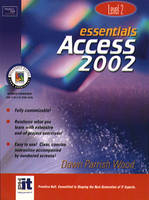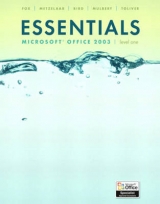
Essentials
Pearson (Verlag)
978-0-13-092760-6 (ISBN)
- Titel erscheint in neuer Auflage
- Artikel merken
The Essentials Series for Microsoft Office XP has be rewritten and redesigned to meet the needs of today's classroom. These hands-on tutorials with a project orientation are designed to give students a thorough knowledge of software applications. Extensive end-of-project exercises emphasize hands-on skill development.
Marianne Fox—Series editor and coauthor of essentials Excel 2002 Level 1, Level 2, and Level 3. Marianne Fox is an Indiana CPA with B.S. and M.B.A. degrees in Accounting from Indiana University. For more than 20 years, she has enjoyed teaching full-time—initially in Indiana University's School of Business; since 1988 in the College of Business Administration at Butler University. As the co-owner of an Indiana-based consulting firm, Marianne has extensive experience consulting and training in the corporate and continuing education environments. Since 1984, she has coauthored more than 35 computer-related books; and has given presentations on accounting, computer applications, and instructional development topics at a variety of seminars and conferences. Lawrence C. Metzelaar—Series editor and coauthor of essentials Excel 2002 Level 1, Level 2, and Level 3. Lawrence C. Metzelaar earned a B.S. in Business Administration and Computer Science from the University of Maryland, and an Ed.M. and C.A.G.S. in Human Problem Solving from Boston University. Lawrence has more than 30 years of experience with military and corporate mainframe and microcomputer systems. He has taught computer science and Management Information Systems (MIS) courses at the University of Hawaii, Control Data Institute, Indiana University, and Purdue University; currently, he is a full-time faculty member in the College of Business Administration at Butler University. As the co-owner of an Indiana-based consulting firm, he has extensive experience consulting and training in the corporate and continuing education environments. Since 1984, he has co-authored more than 35 computer-related books; and has given presentations on computer applications and instructional development topics at a variety of seminars and conferences. Linda Bird—Author of essentials PowerPoint® and Level 2. Linda Bird specializes in corporate training and support through her company, Software Solutions. She has successfully trained users representing more than 75 businesses, including several Fortune 500 companies. She custom designs many of her training materials. Her clients include Appalachian Electric Power Co., Goodyear, Pillsbury, Rockwell, and Shell Chemical. Her background also includes teaching at Averett College and overseeing computer training for a business training organization. Using her training experience as a springboard, Linda has written numerous books on PowerPoint, Word, Excel, Access, and Windows. Additionally, she has written more than 20 instructor's manuals and contributed to books on a variety of desktop application programs. She has also penned more than 150 magazine articles, as well as monthly how-to columns on PowerPoint and Excel for Smart Computing magazine. Linda, a graduate of the University of Wisconsin, lives near the Great Smoky Mountains in Tennessee with her husband, Lonnie, and daughters, Rebecca and Sarah. Besides authoring books, Linda home-educates her daughters. If she's not writing, you can probably find her trekking around the mountains (or horseback riding) with her family. Keith Mulbery—Author of essentials Word 2002 Level 1, Level 2, and Level 3. Keith Mulbery is an associate professor in the Information Systems Department at Utah Valley State College, where he teaches computer applications courses and assists with curriculum development. Keith received his B.S. and M.Ed. (majoring in Business Education) from Southwestern Oklahoma State University. Keith has written several Word and WordPerfect textbooks. His previous book, MOUS essentials Word 2000, received the Utah Valley State College Board of Trustees Award of Excellence in January 2001. In addition, he was the developmental editor of essentials Word 2000 intermediate and essentials Word 2000 advanced. Keith also conducts hands-on computer application workshops at the local, state, and national levels, including at the National Business Education Association convention. Dawn Parrish Wood—Author of essentials Access 2002 Level 1, Level 2, and Level 3. Dawn Parrish Wood is an independent contractor, and provides software training through her own business, Software Support. She teaches customized courses to local businesses and individuals in order to upgrade employee skills and knowledge of computers. Dawn has written materials for these specialized courses for her own use. She also provides software consultation to local businesses. Previously, she was the computer coordinator/lead instructor for the Business & Industry Services division at Valdosta Technical Institute in Valdosta, Georgia. The majority of the coursework she taught was in continuing education. Prior to teaching, she worked as a technical support representative and technical writer for a software firm. She lives in Valdosta, Georgia, with her husband, Kenneth, and their two daughters, Micaela (4 1/2 years) and Kendra (2 1/2 years). Both girls have been her superlative students, learning more on the computer every day.
PROJECT 1. MAKING DATA ENTRY EASIER AND MORE ACCURATE.
Lesson 1. Creating Consistent Data Formats.
Lesson 2. Creating Conditional Formats.
Lesson 3. Creating an Input Mask.
Lesson 4. Restricting Entries to Those That Meet Validation Criteria.
Lesson 5. Requiring Entry of Necessary Information.
Lesson 6. Preventing Duplicate Entries Using Indexed Fields.
Lesson 7. Creating a Lookup Column to Allow Selection from a List.
PROJECT 2. MANAGING DATA USING SMALLER, RELATED TABLES.
Lesson 1. Designing Related Tables to Hold Repetitive Data.
Lesson 2. Defining the Relationship Between Tables.
Lesson 3. Creating Queries That Draw Data from One of the Joined Tables.
Lesson 4. Automatically Filling in Data from One of the Joined Tables.
Lesson 5. Updating Tables by Changing the Query.
Lesson 6. Finding Duplicate Records in an Existing Table.
PROJECT 3. ADDING USING FEATURES TO YOUR FORMS.
Lesson 1. Adding Formats in the Form Design View.
Lesson 2. Selecting Entries from a List.
Lesson 3. Looking Up Valid Entries from a Table of Query.
Lesson 4. Entering the Current Date in a Field Automatically.
Lesson 5. Adding the Current Date and Time to a Form Automatically.
Lesson 6. Changing the Tab Order.
Lesson 7. Using Information from a Query to Fill In Fields Automatically.
Lesson 8. Creating Subforms.
Lesson 9. Printing the Form for Filing Purposes.
PROJECT 4. SPECIAL-PURPOSE REPORTS AND ADVANCED REPORT FEATURES.
Lesson 1. Creating a Report Using the Report Wizard.
Lesson 2. Creating Calculated Fields in a Report.
Lesson 3. Grouping and Sorting Data in a Report.
Lesson 4. Keeping Grouped Data Together in Reports.
Lesson 5. Adding Calculated Fields to Group Headers and Footers.
Lesson 6. Creating Labels for Mailings.
PROJECT 5. MAKING THE INPUT FORM MORE USER FRIENDLY.
Lesson 1. Changing the Color of Text, Backgrounds, and Borders Using Buttons.
Lesson 2. Using the Format Painter to Copy Formats Between Controls.
Lesson 3. Formatting More Than One Control at a Time.
Lesson 4. Changing Colors Using Properties.
Lesson 5. Adding Status Bar Instructions in the Form View.
Lesson 6. Adding Customized ControlTips to Controls.
Lesson 7. Creating a Custom Toolbar.
PROJECT 6. MANAGING YOUR DATABASES WITH SPECIAL ACTION QUERIES AND DATABASE UTILITIES.
Lesson 1. Making Backup Copies of Your Data.
Lesson 2. Saving an Access 2002 Database as an Access 2000 Database.
Lesson 3. Compacting and Repairing Files for Efficient Storage.
Lesson 4. Using Detect and Repair to Fix Access Problems.
Lesson 5. Replicating Your Database.
PROJECT 7. USING ACCESS ON THE WEB AND LINKING TO OTHER DOCUMENTS.
Lesson 1. Adding Hyperlinks from Forms to Word Documents.
Lesson 2. Adding Hyperlinks from Forms to Excel Documents.
Lesson 3. Saving Database Objects As Static HTML Pages.
Lesson 4. Viewing HTML Pages on a Local Drive Using a Browser.
Lesson 5. Editing HTML Pages in WordPad.
Lesson 6. Creating a Data Access Page Using Design View.
Lesson 7. Creating PivotTables and PivotCharts in Data Access Pages.
| Erscheint lt. Verlag | 15.7.2002 |
|---|---|
| Sprache | englisch |
| Maße | 16 x 277 mm |
| Gewicht | 618 g |
| Themenwelt | Mathematik / Informatik ► Informatik ► Datenbanken |
| Informatik ► Office Programme ► Access | |
| ISBN-10 | 0-13-092760-0 / 0130927600 |
| ISBN-13 | 978-0-13-092760-6 / 9780130927606 |
| Zustand | Neuware |
| Haben Sie eine Frage zum Produkt? |
aus dem Bereich



